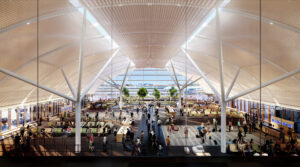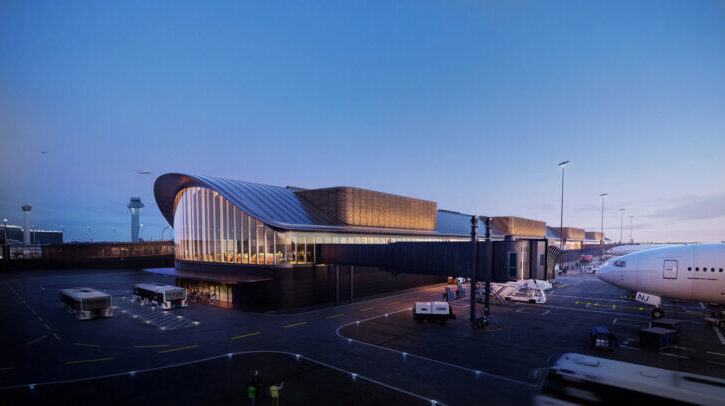Mayor Brandon Johnson and the Chicago Department of Aviation (CDA) have revealed the design for the Satellite 1 Concourse at Chicago O’Hare International Airport in Illinois – the first new building in the Terminal Area Program (TAP).
Chicago O’Hare’s Satellite 1 Concourse
As one of the first domestic-international code-share concourses in Chicago, Satellite 1 has been designed to flexibly accommodate different aircraft bodies, increasing efficiency for carriers and layover passengers.

Reportedly inspired by the orchard that gave O’Hare its original name (Orchard Field), a tree-like structural system inside the concourse eliminates almost half the columns at the gates. This is intended to reduce congestion and enable more efficient boarding and improved visibility for passengers.
The modern design is tuned to the climate of the Midwest, finding efficiencies that prioritize well-being while also improving environmental performance. The branching structural system reduces the embodied carbon of the building; the curved roof profile minimizes heating and cooling needs, strategically overhanging to create shade during peak sun conditions while central skylights create daylit waiting areas year-round. High-performance mechanical and electrical systems also reduce energy use and greenhouse gas emissions.
A connection from the existing Concourse C will drop passengers in an atrium, where connecting or departing passengers can relax in a garden-like setting that has daylight from an oculus skylight above. Selected materials throughout the interior extend this natural palette, offering warmth and acoustic absorption.

Airport design partners
Designed by Skidmore, Owings & Merrill (SOM) with Ross Barney Architects, Juan Gabriel Moreno Architects (JGMA) and Arup, the concourse will be the first new building in the largest concourse area expansion and revitalization in the airport’s 68-year history.
The SOM-led team was selected in 2019 to design the airport’s two satellite terminals as part of an international design competition and will be the first team to break ground. Despite the challenges that the Covid-19 pandemic posed to the airline and construction industries, the design for Satellite 1 is currently under budget and on track for construction, with on-site work already underway on the airfield to prepare for construction.
“We designed the new satellite concourse to create a frictionless experience for travelers, on par with the best airports in the world,” said Scott Duncan, design partner at SOM. “The gate lounges feature column-free expanses for easy wayfinding, high ceilings to improve views and air circulation, and a daylighting strategy to help align the body’s natural rhythms – all to make the experience of air travel more pleasurable.”

Carol Ross Barney, founder and design principal at Ross Barney Architects, stated, “We are proud to join SOM with JGMA and Arup in designing the new O’Hare International Airport Satellite Concourse 1, where every journey will begin and end amidst the hustle and bustle of global connectivity. We have always advocated for the value of well-designed public spaces, particularly in the context of a major international airport like O’Hare.”
Juan Moreno, president and founder of Juan Gabriel Moreno Architects, added, “It’s an honor to expand on our work at Concourse C to continue to improve the campus of O’Hare, and to work with SOM, Ross Barney Architects and Arup to design a dignified passenger experience for the city and visitors to Chicago.”
“On behalf of Mayor Johnson, I thank SOM, JGMA and Ross Barney Architects for their incredible partnership over the past five years,” said Commissioner Jamie L Rhee of the CDA. “The designs released today showcase the result of that work, and the firms’ continued commitment to meet the city’s budget expectations while still delivering a design that all of Chicago can be proud of.”
In related news, it was recently announced that Chicago O’Hare International Airport is to receive an additional US$40m in Airport Terminal Program grant funds from US President Biden’s Bipartisan Infrastructure Law, bringing the total amount awarded to the airport to US$90m. Click here to read the full story.

